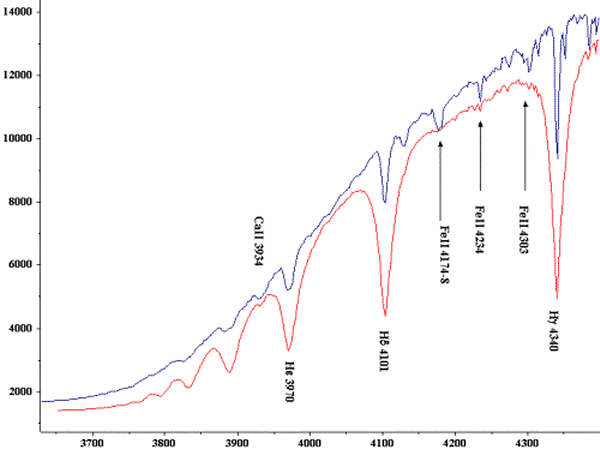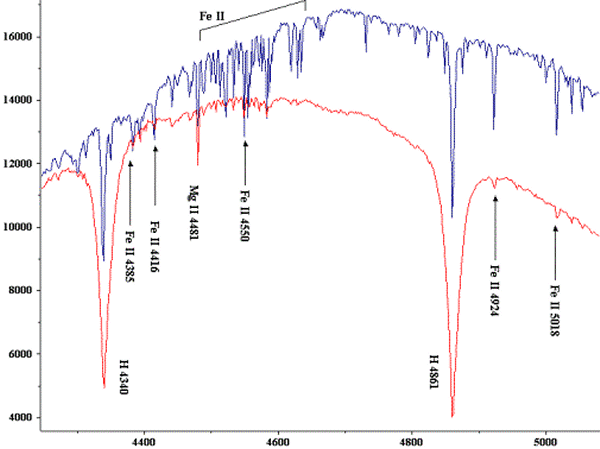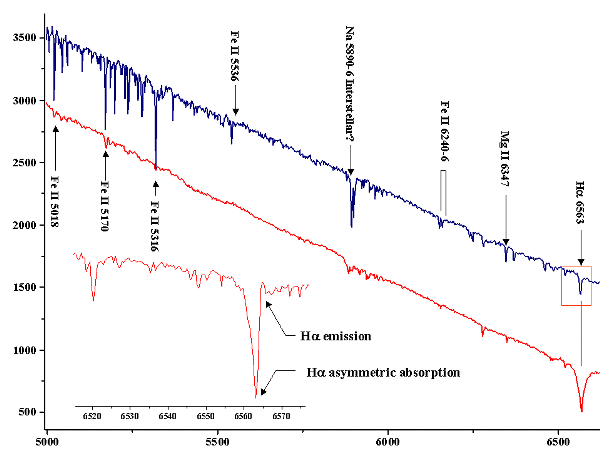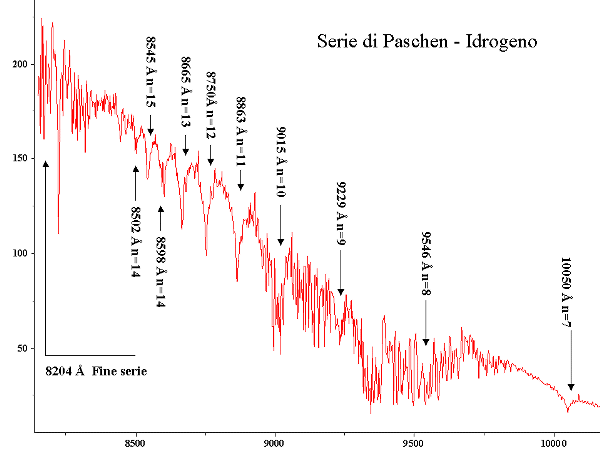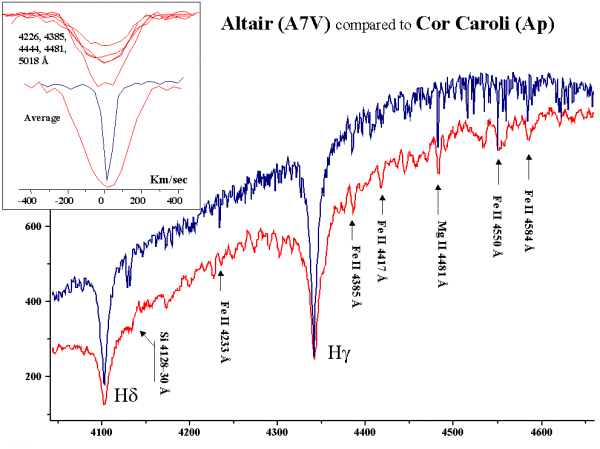|
NORMAL STARS SPECTRA
Spectral classes:
Type A stars
Among the more representative main sequence dwarfs we find:
Vega (A0 V), Sirio (A1 V), Alcor (A5 V), Altair (A7 V)
Among the giants:
b Eridani (A3 III),
a Oph (A5 III),
g Bootis (A7 III)
Among the supergiants:
Deneb (A2 Ia) and
h Leonis (A2 Ib)
In pictures 1-3 spectra of Vega and Deneb are compared. Both spectra have been recorded
with the spectrograph described in the page
ôour instrumentsö.
Looking at the two spectra, we can see an other striking difference in the strength of ions lines
(and in particular Fe II, singly ionized iron) that are stronger in giants than in dwarfs.
In type A stars, Balmer hydrogen lines reach their maximum intensity.
An absorption in the Balmer series is produced when an electron jumps from the second orbit
(n=2 that is 10.2 eV from the fundamental state orbit n=1) to higher n orbits.
Paschen Hydrogen Series in the Near IR spectrum of Vega
Looking at the NIR part of the spectrum of Vega, that is accessible to modern CCD detectors, one can observe also the less known Paschen series of hydrogen (picture 4) that is very similar to the Balmer one except that it origins from electrons that jump from the 3rd orbit instead of jumping from the second one.
Paschen-alfa line is far in the IR at 1,87 mm and thus is not visible with CCDs but starting from Paschen-delta at 10050 ┼ (just on the red edge of CCD detector spectral range) and up to the end of the series at 8204 ┼ all the lines are visible.
Rotation speed of stars measured with Doppler broadening of the spectral absorption lines In late type stars infact the deep convective layer generate a magnetic field that brakes rotation, while for early type stars this layer (and thus the magnetic field) is absent and the rotation remain unchangend during the life of the star. This thery is confirmed by the observation that young stars in open clusters have alla the same rotation speed, independently from their spectral class. Among A type stars we can however find many excepion to this rule. Magnetic A stars (Am), for example, are all very slow rotators even if the origin of their magnetic field is not still understood. The speed of rotation of a star ca be easily deduced from the Doppler broadening of the absorption lines. Rotation broadening cannot be confused with other sources of line broadening because is perfectly symmetric and independent from polarisation of light. Unfortunately Doppler effect allows us only to measure radial velocities and then a star that is viewed with rotation axis close to the line of sight does not show line broadening. The velocities measured with Doppler shift are thus only the radial component Vsin(i) of the rotation speed V, where i is the angle between rotation axis and line of sight. Doppler speeds must thus be considered only as a lower limit to rotation speeds. In the following example (Altair spectrum) can be observed that a common rotation speed of 220 Km/sec produce a 4-5 ┼ broadening of the absorption lines that can be easily observed even at medium resolution (R=5000 for our spectrograph). Rotational broadening is thus a much bigger effect than magnetic Zeeman spitting that achieve only a fraction of ┼ even for the strongest magnetic fields. Among the A stars that show the highest Doppler broadening due to rotation speed we find z Aquilae that spins at 350 Km/sec at the equator.
Peculiar A class stars
Goto other spectral classes:
|
|
1996-2002© Società Astronomica G.V.Schiaparelli - l'uso di testi, immagini e
dati numerici è consentito solo per consultazione e scopo personale.
Per ogni altro utilizzo richiedere autorizzazione a:
|
28/02/2002

